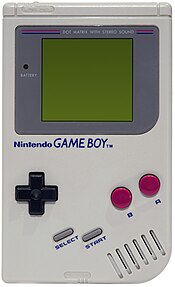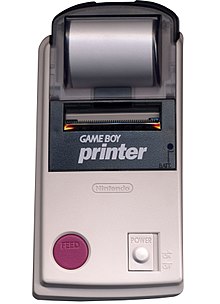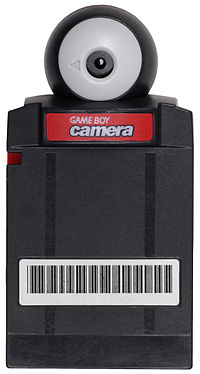The Game Boy (ゲームボーイ, GÄ"mu BÅi) is an 8-bit handheld video game device developed and manufactured by Nintendo. It was released in Japan on April 21, 1989 (1989-04-21), in North America on July 31, 1989 (1989-07-31), and in Europe on September 28, 1990 (1990-09-28). It is the first handheld console in the Game Boy line, and was created by Gunpei Yokoi and Nintendo Research & Development 1â€"the same staff who had designed the Game & Watch series as well as several popular games for the Nintendo Entertainment System. Redesigned versions were released in 1996 and 1998, in the form of Game Boy Pocket, and Game Boy Light (Japan only), respectively.
The Game Boy is Nintendo's second handheld system following the Game & Watch series introduced in 1980, and it combined features from both the Nintendo Entertainment System and Game & Watch. It was originally bundled with the puzzle game Tetris.
As part of the fourth generation of gaming, the Game Boy competed with the Sega Game Gear, Atari Lynx, and the TurboExpress. Despite these other handheld consoles, the Game Boy was a tremendous success. The Game Boy and its successor, the Game Boy Color, have both combined sold 118.69 million units worldwide. Upon its release in the United States, it sold its entire shipment of one million units within a few weeks.
Hardware

The Game Boy has four operation buttons labeled "A", "B", "SELECT", and "START", as well as a directional pad. There is a volume control dial on the right side of the console and a similar knob on the left side to adjust the contrast. At the top of the Game Boy, a sliding on-off switch and the slot for the Game Boy cartridges are located. Nintendo recommends users leave a cartridge in the slot to prevent dust and dirt from entering the system.
The Game Boy also contains optional input and/or output connectors. On the left side of the system is an external 3.5mm x 1.35mm DC power supply jack that allows users to use an external rechargeable battery pack or AC adapter (sold separately) instead of four AA batteries. The Game Boy requires 6Â V DC of at least 150Â mA. A 3.5Â mm stereo headphone jack is located on the bottom side of the console which allows users to listen to the audio with the bundled headphones or external speakers.
The right-side of the device offers a port which allows a user to connect to another Game Boy system via a link cable, provided both users are playing the same game. The port can also be used to connect a Game Boy Printer. The link cable was originally designed for players to play head-to-head two-player games such as in Tetris. However, game developer Satoshi Tajiri would later use the link cable technology as a method of communication and networking in the popular Pokémon video game series.
Technical specifications
- Technical specifications: CPU Custom 8-bit Sharp LR35902 core at 4.19Â MHz. This processor is similar to an Intel 8080 in that none of the registers introduced in the Z80 are present. However, some of the Z80's instruction set enhancements over the stock 8080, particularly bit manipulation, are present. Still other instructions are unique to this particular flavor of Z80 CPU. The core also contains integrated sound generation.
- RAM: 8 kB internal S-RAM (can be extended up to 32 kB)
- Video RAM: 8 kB internal
- ROM: On-CPU-Die 256-byte bootstrap; 256 kb, 512 kb, 1 Mb, 2 Mb, 4 Mb and 8 Mb cartridges
- Sound: 2 pulse wave generators, 1 PCM 4-bit wave sample (64 4-bit samples played in 1×64 bank or 2×32 bank) channel, 1 noise generator, and one audio input from the cartridge. The unit only has one speaker, but headphones provide stereo sound (for further information, see Game Boy music)
- Display: Reflective STN LCD 160 × 144 pixels
- Frame Rate: Approx. 59.7 frames per second on a regular Game Boy, 61.1 on a Super Game Boy
- Vertical Blank Rate: Approx 1.1Â ms
- Screen size: 66Â mm (2.6Â in) diagonal
- Color Palette: 2-bit (4 shades of "gray" {light to very dark olive green})
- Communication: 2 Game Boys can be linked together via built-in serial ports, up to 4 with a DMG-07 4-player adapter.
- Power: 6 V, 0.7 W (4 AA batteries provide 15â€"30+ hours)
- Dimensions: 90 mm (W) × 148 mm (H) × 32 mm (D) / 3.5″ × 5.8″ × 1.3″
Launch games
Revisions

Play It Loud!
On January 1, 1995, Nintendo released several Game Boy models with colored cases, advertising them in the "Play It Loud!" campaign (Japanese name: Game Boy Bros. /ゲームボーイブãƒã‚¹/ゲームボーイブラザース). Specifications for this unit remain exactly the same as the original Game Boy, including the monochromatic screen. This new line of colored Game Boys would set a precedent for later Nintendo handhelds; every one of them since has been available in more than one color. Play It Loud! units were manufactured in red, green, black, yellow, white, blue, and clear (transparent) and RAINBOW cases. Most common are the Clear and yellow. Black, Red and green are less common. Blue is scarce and the White was a Japanese only release. White remains the rarest of all the Play it Loud Colours. A rare, limited edition Manchester United Game Boy is red, with the logos of the team emblazoned on it. It was released simultaneously with the Play it Loud! handhelds in the United Kingdom. The Play It Loud's screens also have a darker border than the normal Game Boy.
Game Boy Pocket
In 1996, Nintendo released the Game Boy Pocket: a smaller, lighter unit that requires fewer batteries. It has space for two AAA batteries, which provides approximately 10 hours of game play. Additionally the unit is also fitted with a 3 volt, 2.35mm x 0.75mm DC jack which can be used to power the system. The Pocket has a smaller link port, which requires an adapter to link with the older Game Boy. The port design is used on all subsequent Game Boy models, excluding the Game Boy Micro. The screen was changed to a true black-and-white display, rather than the "pea soup" monochromatic display of the original Game Boy. Also, the Game Boy Pocket (GBP) has a larger screen than the Game Boy Color (GBC) that later superseded it. The GBP's screen has a 65Â mm (2.56Â in) diagonal, 48.5Â mm (1.91Â in) width, and 43.5Â mm (1.71Â in) height, compared to a 59Â mm (2.32Â in) diagonal for the GBC. Although, like its predecessor, the Game Boy Pocket has no backlight to allow play in a darkened area, it did notably improve visibility and pixel response-time (virtually eliminating video ghosting). The first version did not have a power LED. This was soon added due to public demand, along with new Game Boy Pocket units of different colors (released on April 28, 1997), some of them new to the Game Boy line. There were several limited-edition Game Boy Pockets including a metallic Ice Blue unit and a pink model exclusive to Japan. The Game Boy Pocket was not a new software platform and played the same software as the original Game Boy model.
Game Boy Light
The Game Boy Light was released on April 14, 1998 for ¥6,800 and was only available in Japan. The Game Boy Light is only slightly bigger than the Game Boy Pocket and features an electroluminescent backlight for low-light conditions. It uses 2 AA batteries, which gave it approximately 20 hours with the light off and 12 with it on. It was available in two standard colors, gold and silver, as well as numerous special editions - an Astro Boy edition with a clear case with an Astro Boy picture on it, an Osamu Tezuka World shop edition with a clear red case and a picture of his characters, a solid yellow Pokémon Center Tokyo version, a clear 'skeleton' Famitsu edition which had only 5,000 units released, and a clear yellow edition separate from the Pokémon Center Tokyo version.
Reception
In its first two weeks in Japan, from its release on April 21, 1989, the entire stock consisting of 300,000 units was sold; a few months later, the Game Boy's release in the United States on July 31, 1989 saw 40,000 units sold on its first day. The Game Boy and Game Boy Color combined have sold 118.69 million units worldwide, with 32.47 million units in Japan, 44.06 million in the Americas, and 42.16 million in other regions. By Japanese fiscal year 1997, before Game Boy Color's release in late-1998, the Game Boy alone had sold 64.42 million units worldwide. At a March 14, 1994 press conference in San Francisco, Nintendo vice president of marketing Peter Main answered queries about when Nintendo was coming out with a color handheld system by stating that sales of the Game Boy were strong enough that they had decided to hold off on developing a successor handheld for the near future.
In 1995, Nintendo of America announced that 46% of Game Boy players were female, which was higher than the percentage of female players for both the Nintendo Entertainment System (29%) and Super Nintendo Entertainment System (14%). In 2009, the Game Boy was inducted into the National Toy Hall of Fame, 20 years after its introduction. As of June 6, 2011, Game Boy and Game Boy Color games are available on the Virtual Console service on the Nintendo 3DS's Nintendo eShop.
See also

- List of Game Boy colors and styles
- List of games for the original Game Boy
- Game Boy accessories (description of some selected accessories)
- Game Boy Advance
- Game Boy line
- Microvision, the first handheld to use cartridges
References
- "Game Boy Compact Video Game System Owner's Manual". Nintendo. 1989. DMG-GB-UKV.Â
- Kent, Steven L. (2001). The Ultimate History of Video Games (1st ed.). Roseville, CA: Prima Publishing. ISBNÂ 0-7615-3643-4.Â
- Hand-held electronic game - Design patent for the case
External links

Media related to Game Boy at Wikimedia Commons
- Official website
- Game Boy at Nintendo.com (archived versions at the Internet Archive Wayback Machine)
- Game Boy (original) games list at Nintendo.com (archived from the original at the Internet Archive Wayback Machine)
- Game Boy at DMOZ
- Game_Boy at Nintendopedia.


Posting Komentar